Arcmap No Polygons Were Created Ensure the Selected Form Continuous Rings and Overlap the Polygons
Editing¶
- Setting the Snapping Tolerance and Search Radius
- Snapping tolerance
- Search radius
- Topological editing
- Enable topological editing
- Avoid intersections of new polygons
- Enable snapping on intersections
- Geometry Checker
- Digitizing an existing layer
- Adding Features
- Node Tool
- Basic operations
- The Vertex Editor
- Cutting, Copying and Pasting Features
- Deleting Selected Features
- Saving Edited Layers
- Saving multiple layers at once
- Advanced digitizing
- Undo and Redo
- Rotate Feature(s)
- Simplify Feature
- Add Part
- Delete Part
- Add Ring
- Fill Ring
- Delete Ring
- Reshape Features
- Offset Curves
- Split Features
- Split parts
- Merge selected features
- Merge attributes of selected features
- Rotate Point Symbols
- Offset Point Symbols
- Automatic Tracing
- The Advanced Digitizing panel
- Concepts
- Snapping Settings
- Keyboard shortcuts
- Absolute reference digitizing
- Relative reference digitizing
- Continuous lock
- Parallel and perpendiculars line
- Construction mode
QGIS supports various capabilities for editing OGR, SpatiaLite, PostGIS, MSSQL Spatial and Oracle Spatial vector layers and tables.
Tip
Concurrent Edits
This version of QGIS does not track if somebody else is editing the same feature at the same time as you are. The last person to save its edits wins.
Setting the Snapping Tolerance and Search Radius¶
For an optimal and accurate edit of the vector layer geometries, we need to set an appropriate value of snapping tolerance and search radius for features vertices.
Snapping tolerance¶
Snapping tolerance is the distance QGIS uses to search for the closest vertex and/or segment you are trying to connect to when you set a new vertex or move an existing vertex. If you aren't within the snapping tolerance, QGIS will leave the vertex where you release the mouse button, instead of snapping it to an existing vertex and/or segment. The snapping tolerance setting affects all tools that work with tolerance.
- A general, project-wide snapping tolerance can be defined by choosing
 , Digitizing tab. You can select between 'To vertex', 'To segment' or 'To vertex and segment' as default snap mode. You can also define a default snapping tolerance and a search radius for vertex edits. The tolerance can be set either in map units or in pixels. The advantage of choosing pixels is that the snapping tolerance doesn't have to be changed after zoom operations. In our small digitizing project (working with the Alaska dataset), we define the snapping units in feet. Your results may vary, but something on the order of 300 ft at a scale of 1:10000 should be a reasonable setting.
, Digitizing tab. You can select between 'To vertex', 'To segment' or 'To vertex and segment' as default snap mode. You can also define a default snapping tolerance and a search radius for vertex edits. The tolerance can be set either in map units or in pixels. The advantage of choosing pixels is that the snapping tolerance doesn't have to be changed after zoom operations. In our small digitizing project (working with the Alaska dataset), we define the snapping units in feet. Your results may vary, but something on the order of 300 ft at a scale of 1:10000 should be a reasonable setting. - A layer-based snapping tolerance that overrides the global snapping options can be defined by choosing . It enables and adjusts snapping mode and tolerance on a layer basis (see figure_edit_snapping ). This dialog offers three different modes to select the layer(s) to snap to:
- Current layer: only the active layer is used, a convenient way to ensure topology within the layer being edited
- All layers: a quick and simple setting for all visible layers in the project so that the pointer snaps to all vertices and/or segments. In most cases it is sufficient to use this snapping mode.
- Advanced: if you need to edit a layer and snap its vertices to another layer, ensure the target layer is checked and increase the snapping tolerance to a greater value. Furthermore, snapping will never occur to a layer that is not checked in the snapping options dialog, regardless of the global snapping tolerance. So be sure to mark the checkbox for those layers that you need to snap to.
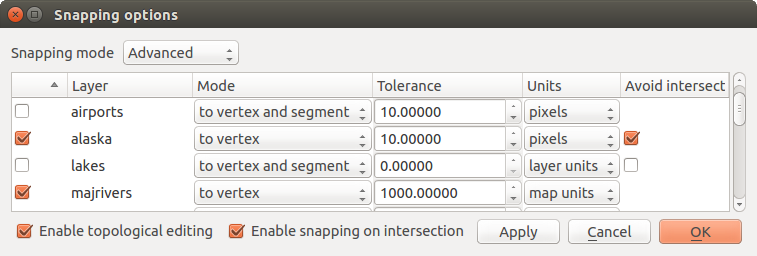
Edit snapping options on a layer basis (Advanced mode)
Tip
Control the list of layers to snap
The Snapping Options dialog is by default populated with parameters (mode, tolerance, units) set in the global Digitizing tab. To avoid layers being checked by default in the Advanced mode and hence set snappable, define the Default Snap mode to Off .
Snapping tolerance can be set in pixels or map units (the units of the map view). While in the Advanced layer selection mode, it is possible to use a snapping tolerance that refers to layer units , the units of the reprojected layer when 'on-the-fly' CRS transformation is on.
Search radius¶
Search radius is the distance QGIS uses to search for the closest vertex you are trying to select when you click on the map. If you aren't within the search radius, QGIS won't find and select any vertex for editing. The search radius for vertex edits can be defined under  tab. This is the same place where you define the general, project-wide snapping tolerance.
tab. This is the same place where you define the general, project-wide snapping tolerance.
Snap tolerance and search radius are set in map units or pixels , so you may find you need to experiment to get them set right. If you specify too big of a tolerance, QGIS may snap to the wrong vertex, especially if you are dealing with a large number of vertices in close proximity. Set search radius too small, and it won't find anything to move.
Topological editing¶
Besides layer-based snapping options, you can also define topological functionalities in the Snapping options... dialog in the (or ) menu. Here, you can define  Enable topological editing, and/or for polygon layers, activate the
Enable topological editing, and/or for polygon layers, activate the  Avoid Intersections option.
Avoid Intersections option.
Enable topological editing¶
The option  Enable topological editing is for editing and maintaining common boundaries in features mosaics. QGIS 'detects' shared boundary by the features, so you only have to move a common vertex/segment once, and QGIS will take care of updating the neighboring features.
Enable topological editing is for editing and maintaining common boundaries in features mosaics. QGIS 'detects' shared boundary by the features, so you only have to move a common vertex/segment once, and QGIS will take care of updating the neighboring features.
Avoid intersections of new polygons¶
A second topological option called  Avoid intersections prevents you to draw new features that overlap an existing one. It is for quicker digitizing of adjacent polygons. If you already have one polygon, it is possible with this option to digitize the second one such that both intersect, and QGIS then cuts the second polygon to the boundary of the existing one. The advantage is that you don't have to digitize all vertices of the common boundary.
Avoid intersections prevents you to draw new features that overlap an existing one. It is for quicker digitizing of adjacent polygons. If you already have one polygon, it is possible with this option to digitize the second one such that both intersect, and QGIS then cuts the second polygon to the boundary of the existing one. The advantage is that you don't have to digitize all vertices of the common boundary.
Note
If the new geometry is totally covered by existing ones, it gets cleared and the new feature will have no geometry when allowed by the provider, otherwise saving modifications will make QGIS pop-up an error message.
Warning
Use cautiously the Avoid Intersections option
Because the option cuts or clears geometry of any overlaping feature from any polygon layer, do not forget to uncheck this option once you no longer need it otherwise, you can get unexpected geometries.
Enable snapping on intersections¶
Another option is to use  Enable snapping on intersection. It allows you to snap on an intersection of background layers, even if there's no vertex on the intersection.
Enable snapping on intersection. It allows you to snap on an intersection of background layers, even if there's no vertex on the intersection.
Geometry Checker¶
A core plugin can help the user to find the geometry invalidity. You can find more information on this plugin at Geometry Checker Plugin.
Digitizing an existing layer¶
By default, QGIS loads layers read-only. This is a safeguard to avoid accidentally editing a layer if there is a slip of the mouse. However, you can choose to edit any layer as long as the data provider supports it (see Exploring Data Formats and Fields), and the underlying data source is writable (i.e., its files are not read-only).
Tip
Restrict edit permission on layers within a project
From the tab, You can choose to set any layer read-only regardless the provider permission. This can be a handy way, in a multi-users environment to avoid unauthorized users to mistakenly edit layers (e.g., shapefile), hence potentially corrupt data. Note that this setting only applies inside the current project.
In general, tools for editing vector layers are divided into a digitizing and an advanced digitizing toolbar, described in section Advanced digitizing. You can select and unselect both under . Using the basic digitizing tools, you can perform the following functions:
| Icon | Purpose | Icon | Purpose |
|---|---|---|---|
 | Current edits |  | Toggle editing |
 | Add Feature: Capture Point |  | Add Feature: Capture Line |
 | Add Feature: Capture Polygon |  | Move Feature |
 | Add Circular String |  | Add Circular String By Radius |
 | Node Tool | 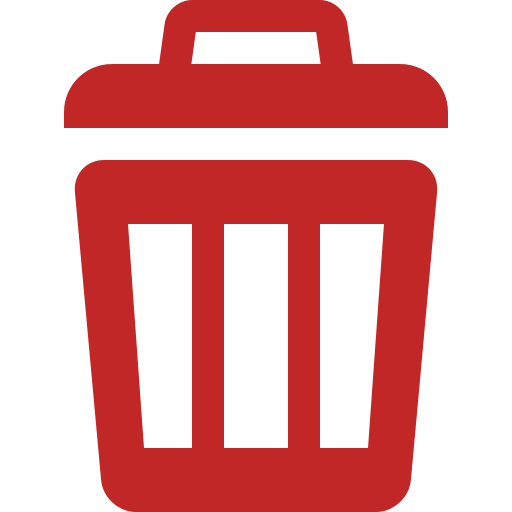 | Delete Selected |
 | Cut Features |  | Copy Features |
 | Paste Features |  | Save layer edits |
Table Editing: Vector layer basic editing toolbar
Note that while using any of the digitizing tools, you can still zoom or pan in the map canvas without losing the focus on the tool.
All editing sessions start by choosing the  Toggle editing option found in the context menu of a given layer, from the attribute table dialog, the digitizing toolbar or the menu.
Toggle editing option found in the context menu of a given layer, from the attribute table dialog, the digitizing toolbar or the menu.
Once the layer is in edit mode, additional tool buttons on the editing toolbar will become available and markers will appear at the vertices of all features unless Show markers only for selected features option under menu is checked.
Tip
Save Regularly
Remember to  Save Layer Edits regularly. This will also check that your data source can accept all the changes.
Save Layer Edits regularly. This will also check that your data source can accept all the changes.
Adding Features¶
You can use the  Add Feature,
Add Feature,  Add Feature or
Add Feature or  Add Feature icons on the toolbar to add new feature (point, line and polygon) into the current layer.
Add Feature icons on the toolbar to add new feature (point, line and polygon) into the current layer.
The next buttons  Add circular string or
Add circular string or  Add circular string by radius allow users to add line or polygon features with a circular geometry.
Add circular string by radius allow users to add line or polygon features with a circular geometry.
To create features with these tools, you first digitize the geometry then enter its attributes. To digitize the geometry, left-click on the map area to create the first point of your new feature.
For linear or curved geometries, keep on left-clicking for each additional point you wish to capture or use automatic tracing capability to accelerate the digitization. You can switch back and forth between linear Add feature tool and curved Add circular string... tools to create compound curved geometry. Pressing Delete or Backspace key reverts the last node you add. When you have finished adding points, right-click anywhere on the map area to confirm you have finished entering the geometry of that feature.
Note
Curved geometries are stored as such only in compatible data provider
Although QGIS allows to digitize curved geometries within any editable data format, you need to be using a data provider (e.g. PostGIS, GML or WFS) that supports curves to have features stored as curved, otherwise QGIS segmentizes the circular arcs. The memory layer provider also supports curves.
Tip
Customize the digitizing rubber band
While capturing polygon, the by-default red rubber band can hide underlying features or places you'd like to capture a point. This can be fixed by setting a lower opacity (or alpha channel) to the rubber band's Fill Color in menu. You can also avoid the use of the rubber band by checking Don't update rubber band during node editing.
The attribute window will appear, allowing you to enter the information for the new feature. Figure_edit_values shows setting attributes for a fictitious new river in Alaska. However, in the Digitizing menu under the menu, you can also activate:
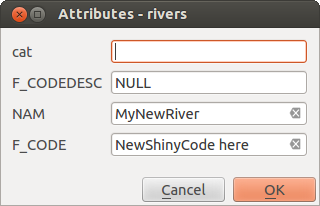
Enter Attribute Values Dialog after digitizing a new vector feature
With the  Move Feature(s) icon on the toolbar, you can move existing features.
Move Feature(s) icon on the toolbar, you can move existing features.
Cutting, Copying and Pasting Features¶
Selected features can be cut, copied and pasted between layers in the same QGIS project, as long as destination layers are set to  Toggle editing beforehand.
Toggle editing beforehand.
Tip
Transform polygon into line and vice-versa using copy/paste
Copy a line feature and paste it in a polygon layer: QGIS pastes in the target layer a polygon whose boundary corresponds to the closed geometry of the line feature. This is a quick way to generate different geometries of the same data.
Features can also be pasted to external applications as text. That is, the features are represented in CSV format, with the geometry data appearing in the OGC Well-Known Text (WKT) format. WKT and GeoJSON features from outside QGIS can also be pasted to a layer within QGIS.
When would the copy and paste function come in handy? Well, it turns out that you can edit more than one layer at a time and copy/paste features between layers. Why would we want to do this? Say we need to do some work on a new layer but only need one or two lakes, not the 5,000 on our big_lakes layer. We can create a new layer and use copy/paste to plop the needed lakes into it.
As an example, we will copy some lakes to a new layer:
- Load the layer you want to copy from (source layer)
- Load or create the layer you want to copy to (target layer)
- Start editing for target layer
- Make the source layer active by clicking on it in the legend
- Use the
 Select Features by area or single click tool to select the feature(s) on the source layer
Select Features by area or single click tool to select the feature(s) on the source layer - Click on the
 Copy Features tool
Copy Features tool - Make the destination layer active by clicking on it in the legend
- Click on the
 Paste Features tool
Paste Features tool - Stop editing and save the changes
What happens if the source and target layers have different schemas (field names and types are not the same)? QGIS populates what matches and ignores the rest. If you don't care about the attributes being copied to the target layer, it doesn't matter how you design the fields and data types. If you want to make sure everything - the feature and its attributes - gets copied, make sure the schemas match.
Note
Congruency of Pasted Features
If your source and destination layers use the same projection, then the pasted features will have geometry identical to the source layer. However, if the destination layer is a different projection, then QGIS cannot guarantee the geometry is identical. This is simply because there are small rounding-off errors involved when converting between projections.
Tip
Copy string attribute into another
If you have created a new column in your attribute table with type 'string' and want to paste values from another attribute column that has a greater length the length of the column size will be extended to the same amount. This is because the GDAL Shapefile driver starting with GDAL/OGR 1.10 knows to auto-extend string and integer fields to dynamically accommodate for the length of the data to be inserted.
Deleting Selected Features¶
If we want to delete an entire feature (attribute and geometry), we can do that by first selecting the geometry using the regular  Select Features by area or single click tool. Selection can also be done from the attribute table. Once you have the selection set, press Delete or Backspace key or use the
Select Features by area or single click tool. Selection can also be done from the attribute table. Once you have the selection set, press Delete or Backspace key or use the  Delete Selected tool to delete the features. Multiple selected features can be deleted at once.
Delete Selected tool to delete the features. Multiple selected features can be deleted at once.
The  Cut Features tool on the digitizing toolbar can also be used to delete features. This effectively deletes the feature but also places it on a "spatial clipboard". So, we cut the feature to delete. We could then use the
Cut Features tool on the digitizing toolbar can also be used to delete features. This effectively deletes the feature but also places it on a "spatial clipboard". So, we cut the feature to delete. We could then use the  Paste Features tool to put it back, giving us a one-level undo capability. Cut, copy, and paste work on the currently selected features, meaning we can operate on more than one at a time.
Paste Features tool to put it back, giving us a one-level undo capability. Cut, copy, and paste work on the currently selected features, meaning we can operate on more than one at a time.
Saving Edited Layers¶
When a layer is in editing mode, any changes remain in the memory of QGIS. Therefore, they are not committed/saved immediately to the data source or disk. If you want to save edits to the current layer but want to continue editing without leaving the editing mode, you can click the  Save Layer Edits button. When you turn editing mode off with
Save Layer Edits button. When you turn editing mode off with  Toggle editing (or quit QGIS for that matter), you are also asked if you want to save your changes or discard them.
Toggle editing (or quit QGIS for that matter), you are also asked if you want to save your changes or discard them.
If the changes cannot be saved (e.g., disk full, or the attributes have values that are out of range), the QGIS in-memory state is preserved. This allows you to adjust your edits and try again.
Tip
Data Integrity
It is always a good idea to back up your data source before you start editing. While the authors of QGIS have made every effort to preserve the integrity of your data, we offer no warranty in this regard.
Saving multiple layers at once¶
This feature allows the digitization of multiple layers. Choose  Save for Selected Layers to save all changes you made in multiple layers. You also have the opportunity to
Save for Selected Layers to save all changes you made in multiple layers. You also have the opportunity to  Rollback for Selected Layers, so that the digitization may be withdrawn for all selected layers. If you want to stop editing the selected layers,
Rollback for Selected Layers, so that the digitization may be withdrawn for all selected layers. If you want to stop editing the selected layers,  Cancel for Selected Layer(s) is an easy way.
Cancel for Selected Layer(s) is an easy way.
The same functions are available for editing all layers of the project.
Tip
Use transaction group to edit, save or rollback multiple layers changes at once
When working with layers from the same PostGreSQL database, activate the Automatically create transaction groups where possible option in to sync their behavior (enter or exit the edit mode, save or rollback changes at the same time).
Advanced digitizing¶
| Icon | Purpose | Icon | Purpose |
|---|---|---|---|
 | Enable Advanced Digitizing Tools |  | Enable Tracing |
 | Undo |  | Redo |
 | Rotate Feature(s) |  | Simplify Feature |
 | Add Ring |  | Add Part |
 | Fill Ring | ||
 | Delete Ring |  | Delete Part |
 | Offset Curve |  | Reshape Features |
 | Split Parts |  | Split Features |
 | Merge Attributes of Selected Features |  | Merge Selected Features |
 | Rotate Point Symbols |  | Offset Point Symbols |
Table Advanced Editing: Vector layer advanced editing toolbar
Undo and Redo¶
The  Undo and
Undo and  Redo tools allows you to undo or redo vector editing operations. There is also a dockable widget, which shows all operations in the undo/redo history (see Figure_edit_undo). This widget is not displayed by default; it can be displayed by right-clicking on the toolbar and activating the Undo/Redo Panel checkbox. The Undo/Redo capability is however active, even if the widget is not displayed.
Redo tools allows you to undo or redo vector editing operations. There is also a dockable widget, which shows all operations in the undo/redo history (see Figure_edit_undo). This widget is not displayed by default; it can be displayed by right-clicking on the toolbar and activating the Undo/Redo Panel checkbox. The Undo/Redo capability is however active, even if the widget is not displayed.
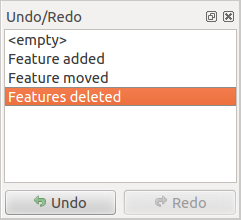
Redo and Undo digitizing steps
When Undo is hit or Ctrl+Z (or Cmd+Z ) pressed, the state of all features and attributes are reverted to the state before the reverted operation happened. Changes other than normal vector editing operations (for example, changes done by a plugin) may or may not be reverted, depending on how the changes were performed.
To use the undo/redo history widget, simply click to select an operation in the history list. All features will be reverted to the state they were in after the selected operation.
Rotate Feature(s)¶
Use  Rotate Feature(s) to rotate one or multiple features in the map canvas. Press the
Rotate Feature(s) to rotate one or multiple features in the map canvas. Press the  Rotate Feature(s) icon and then click on the feature to rotate. Either click on the map to place the rotated feature or enter an angle in the user input widget. If you want to rotate several features, they shall be selected first.
Rotate Feature(s) icon and then click on the feature to rotate. Either click on the map to place the rotated feature or enter an angle in the user input widget. If you want to rotate several features, they shall be selected first.
If you enable the map tool with feature(s) selected, its (their) centroid appears and will be the rotation anchor point. If you want to move the anchor point, hold the Ctrl button and click on the map to place it.
If you hold Shift before clicking on the map, the rotation will be done in 45 degree steps, which can be modified afterwards in the user input widget.
To abort feature rotation, you need to click on  Rotate Feature(s) icon.
Rotate Feature(s) icon.
Simplify Feature¶
The  Simplify Feature tool allows you to reduce the number of vertices of a feature, as long as the geometry remains valid. With the tool you can also simplify many features at once or multi-part features.
Simplify Feature tool allows you to reduce the number of vertices of a feature, as long as the geometry remains valid. With the tool you can also simplify many features at once or multi-part features.
First, click on the feature or drag a rectangle over the features. A dialog where you can define a tolerance in map units , layer units or pixels pops up and a colored and simplified copy of the feature(s), using the given tolerance, appears over them. QGIS calculates the amount of vertices that can be deleted while maintaining the geometry. The higher the tolerance is the more vertices can be deleted. When the expected geometry fits your needs just click the [OK] button. The tolerance you used will be saved when leaving a project or when leaving an edit session. So you can go back to the same tolerance the next time when simplifying a feature.
To abort feature simplification, you need to click on  Simplify Feature icon.
Simplify Feature icon.
Note
Unlike the feature simplification option in menu which simplifies the geometry just for rendering, the  Simplify Feature tool permanently modifies feature's geometry in data source.
Simplify Feature tool permanently modifies feature's geometry in data source.
Add Part¶
You can  Add Part to a selected feature generating a multipoint, multiline or multipolygon feature. The new part must be digitized outside the existing one which should be selected beforehand.
Add Part to a selected feature generating a multipoint, multiline or multipolygon feature. The new part must be digitized outside the existing one which should be selected beforehand.
The  Add Part can also be used to add a geometry to a geometryless feature. First, select the feature in the attribute table and digitize the new geometry with the
Add Part can also be used to add a geometry to a geometryless feature. First, select the feature in the attribute table and digitize the new geometry with the  Add Part tool.
Add Part tool.
Delete Part¶
The  Delete Part tool allows you to delete parts from multifeatures (e.g., to delete polygons from a multi-polygon feature). This tool works with all multi-part geometries: point, line and polygon. Furthermore, it can be used to totally remove the geometric component of a feature. To delete a part, simply click within the target part.
Delete Part tool allows you to delete parts from multifeatures (e.g., to delete polygons from a multi-polygon feature). This tool works with all multi-part geometries: point, line and polygon. Furthermore, it can be used to totally remove the geometric component of a feature. To delete a part, simply click within the target part.
Add Ring¶
You can create ring polygons using the  Add Ring icon in the toolbar. This means that inside an existing area, it is possible to digitize further polygons that will occur as a 'hole', so only the area between the boundaries of the outer and inner polygons remains as a ring polygon.
Add Ring icon in the toolbar. This means that inside an existing area, it is possible to digitize further polygons that will occur as a 'hole', so only the area between the boundaries of the outer and inner polygons remains as a ring polygon.
Fill Ring¶
You can use the  Fill Ring function to add a ring to a polygon and add a new feature to the layer at the same time. Using this tool, you simply have to digitize a polygon within an existing one. Thus you need not first use the
Fill Ring function to add a ring to a polygon and add a new feature to the layer at the same time. Using this tool, you simply have to digitize a polygon within an existing one. Thus you need not first use the  Add Ring icon and then the
Add Ring icon and then the  Add feature function anymore.
Add feature function anymore.
Delete Ring¶
The  Delete Ring tool allows you to delete rings within an existing polygon, by clicking inside the hole. This tool only works with polygon and multi-polygon features. It doesn't change anything when it is used on the outer ring of the polygon.
Delete Ring tool allows you to delete rings within an existing polygon, by clicking inside the hole. This tool only works with polygon and multi-polygon features. It doesn't change anything when it is used on the outer ring of the polygon.
Reshape Features¶
You can reshape line and polygon features using the  Reshape Features tool on the toolbar. For lines, it replaces the line part from the first to the last intersection with the original line.
Reshape Features tool on the toolbar. For lines, it replaces the line part from the first to the last intersection with the original line.
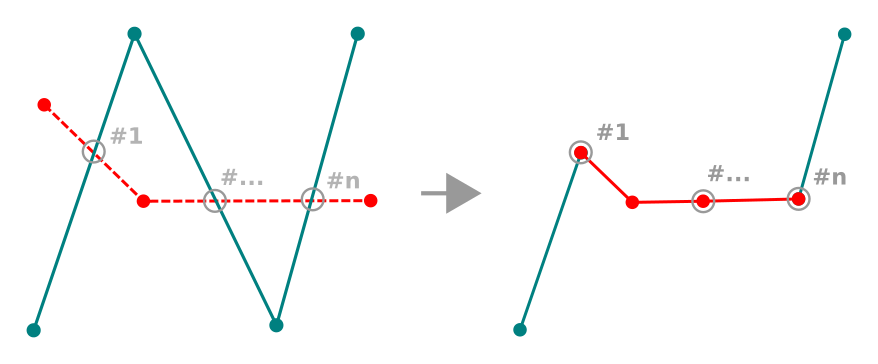
Reshape line
Tip
Extend linestring geometries with reshape tool
Use the  Reshape Features tool to extend existing linestring geometries: snap to the first or last vertex of the line and draw a new one. Validate and the feature's geometry becomes the combination of the two lines.
Reshape Features tool to extend existing linestring geometries: snap to the first or last vertex of the line and draw a new one. Validate and the feature's geometry becomes the combination of the two lines.
For polygons, it will reshape the polygon's boundary. For it to work, the reshape tool's line must cross the polygon's boundary at least twice. To draw the line, click on the map canvas to add vertexes. To finish it, just right-click. Like with the lines, only the segment between the first and the last intersections is considered. The reshape line's segments that are inside the polygon will result in cropping it, where the ones outside the polygon will extend it.
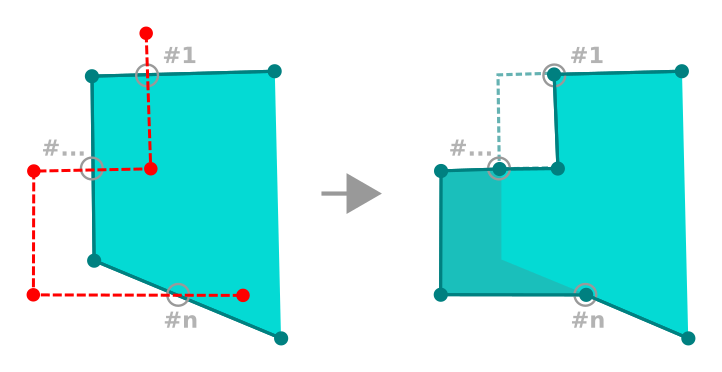
Reshape polygon
With polygons, reshaping can sometimes lead to unintended results. It is mainly useful to replace smaller parts of a polygon, not for major overhauls, and the reshape line is not allowed to cross several polygon rings, as this would generate an invalid polygon.
Note
The reshape tool may alter the starting position of a polygon ring or a closed line. So, the point that is represented 'twice' will not be the same any more. This may not be a problem for most applications, but it is something to consider.
Offset Curves¶
The  Offset Curve tool creates parallel shifts of line layers. The tool can be applied to the edited layer (the geometries are modified) or also to background layers (in which case it creates copies of the lines / rings and adds them to the edited layer). It is thus ideally suited for the creation of distance line layers. The User Input dialog pops-up, showing the displacement distance.
Offset Curve tool creates parallel shifts of line layers. The tool can be applied to the edited layer (the geometries are modified) or also to background layers (in which case it creates copies of the lines / rings and adds them to the edited layer). It is thus ideally suited for the creation of distance line layers. The User Input dialog pops-up, showing the displacement distance.
To create a shift of a line layer, you must first go into editing mode and activate the  Offset Curve tool. Then click on a feature to shift it. Move the mouse and click where wanted or enter the desired distance in the user input widget. Your changes may then be saved with the
Offset Curve tool. Then click on a feature to shift it. Move the mouse and click where wanted or enter the desired distance in the user input widget. Your changes may then be saved with the  Save Layer Edits tool.
Save Layer Edits tool.
QGIS options dialog (Digitizing tab then Curve offset tools section) allows you to configure some parameters like Join style, Quadrant segments, Miter limit.
Split Features¶
You can split features using the  Split Features icon on the toolbar. Just draw a line across the feature you want to split.
Split Features icon on the toolbar. Just draw a line across the feature you want to split.
Split parts¶
In QGIS it is possible to split the parts of a multi part feature so that the number of parts is increased. Just draw a line across the part you want to split using the  Split Parts icon.
Split Parts icon.
Tip
Split a polyline feature in one-click
A single click on a snapped vertex of a line feature with the  Split Features or
Split Features or  Split Parts tool is enough to have it split into new features or parts.
Split Parts tool is enough to have it split into new features or parts.
Merge selected features¶
The  Merge Selected Features tool allows you to create a new feature by merging existing ones: their geometries are merged to generate a new one. If features don't have common boundaries, a multipolygon/multipolyline/multipoint feature is created.
Merge Selected Features tool allows you to create a new feature by merging existing ones: their geometries are merged to generate a new one. If features don't have common boundaries, a multipolygon/multipolyline/multipoint feature is created.
First, select several features. Then press the  Merge Selected Features button. In the new dialog, you can select at the top of the dialog which value to apply to each field of the new feature. That value can be:
Merge Selected Features button. In the new dialog, you can select at the top of the dialog which value to apply to each field of the new feature. That value can be:
- picked from the attributes of the initial features,
- an aggregation of the initial features attributes (Minimum, Maximum, Median, Sum, Count Concatenation... depending on the type of the field. see Statistical Summary Panel for the full list of functions),
- skipped, meaning that the field will be empty,
- or manually entered, at the bottom of the rows.
Merge attributes of selected features¶
The  Merge Attributes of Selected Features tool allows you to apply same attributes to features without merging their boundaries. The dialog is the same as the Merge Selected Features tool's except that unlike that tool, selected objects are kept with their geometry while some of their attributes are made identical.
Merge Attributes of Selected Features tool allows you to apply same attributes to features without merging their boundaries. The dialog is the same as the Merge Selected Features tool's except that unlike that tool, selected objects are kept with their geometry while some of their attributes are made identical.
Rotate Point Symbols¶
The  Rotate Point Symbols allows you to change the rotation of point symbols in the map canvas. First of all, you must apply to the symbol a data-defined rotation: in the dialog, click the
Rotate Point Symbols allows you to change the rotation of point symbols in the map canvas. First of all, you must apply to the symbol a data-defined rotation: in the dialog, click the ![]() Data-defined override widget near the Rotation option of the highest level (preferably) of the symbol layers and choose a field in the Field Type combobox. Values of this field are hence used to rotate each feature's symbol accordingly.
Data-defined override widget near the Rotation option of the highest level (preferably) of the symbol layers and choose a field in the Field Type combobox. Values of this field are hence used to rotate each feature's symbol accordingly.
Note
As a global option, setting the rotation field at the first level of the symbol applies it to all the underlying levels while setting it at a lower level will rotate only this symbol layer (unless you have a single symbol layer).
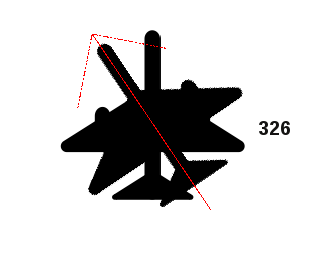
Rotate Point Symbols
To change the rotation of a symbol, click on a point feature in the map canvas with the  Rotate Point Symbols and move the mouse around, holding the left button pressed. A red arrow with the rotation value will be visualized (see Figure_rotate_point). When you release the left mouse button again, the symbol is defined with this new rotation and the rotation field is updated in the layer's attribute table.
Rotate Point Symbols and move the mouse around, holding the left button pressed. A red arrow with the rotation value will be visualized (see Figure_rotate_point). When you release the left mouse button again, the symbol is defined with this new rotation and the rotation field is updated in the layer's attribute table.
Tip
If you hold the Ctrl key pressed, the rotation will be done in 15 degree steps.
Offset Point Symbols¶
The  Offset Point Symbols allows you to interactively change the rendered position of point symbols in the map canvas. This tool behaves like the
Offset Point Symbols allows you to interactively change the rendered position of point symbols in the map canvas. This tool behaves like the  Rotate Point Symbols tool except that it requires you to connect a field to the data-defined Offset (X,Y) property of the symbol, field which will then be populated with the offset coordinates while moving the symbol in the map canvas.
Rotate Point Symbols tool except that it requires you to connect a field to the data-defined Offset (X,Y) property of the symbol, field which will then be populated with the offset coordinates while moving the symbol in the map canvas.
Note
The  Offset Point Symbols tool doesn't move the point feature itself; you should use the
Offset Point Symbols tool doesn't move the point feature itself; you should use the  Node Tool or
Node Tool or  Move Feature tool for this purpose.
Move Feature tool for this purpose.
Warning
Ensure to assign the same field to all symbol layers
If at least two layers of the symbol have different fields assigned to their data-defined property (e.g. rotation), the corresponding tool will consider that no field is assigned to the symbol property and won't perform the action.
Automatic Tracing¶
Usually, when using capturing map tools (add feature, add part, add ring, reshape and split), you need to click each vertex of the feature.
Using the automatic tracing mode you can speed up the digitization process. Enable the  Tracing tool by pushing the icon or pressing t key and snap to a vertex or segment of a feature you want to trace along. Move the mouse over another vertex or segment you'd like to snap and instead of an usual straight line, the digitizing rubber band represents a path from the last point you snapped to the current position. QGIS actually uses the underlying features topology to build the shortest path between the two points. Click and QGIS places the intermediate vertices following the path. You no longer need to manually place all the vertices during digitization.
Tracing tool by pushing the icon or pressing t key and snap to a vertex or segment of a feature you want to trace along. Move the mouse over another vertex or segment you'd like to snap and instead of an usual straight line, the digitizing rubber band represents a path from the last point you snapped to the current position. QGIS actually uses the underlying features topology to build the shortest path between the two points. Click and QGIS places the intermediate vertices following the path. You no longer need to manually place all the vertices during digitization.
Tracing requires snapping to be activated in traceable layers to build the path. You should also snap to an existing vertex or segment while digitizing and ensure that the two nodes are topologically connectable following existing features, otherwise QGIS is unable to connect them and thus traces a single straight line.
Note
Adjust map scale or snapping settings for an optimal tracing
If there are too many features in map display, tracing is disabled to avoid potentially long tracing structure preparation and large memory overhead. After zooming in or disabling some layers the tracing is enabled again.
Tip
Quickly enable or disable automatic tracing by pressing t key
By pressing t key, tracing can be enabled/disabled anytime even while digitizing one feature, so it is possible to digitize some parts of the feature with tracing enabled and other parts with tracing disabled. Tools behave as usual when tracing is disabled.
The Advanced Digitizing panel¶
When capturing, reshaping, splitting new or existing geometries you also have the possibility to use the Advanced Digitizing panel. You can digitize lines exactly parallel or perpendicular to a particular angle or lock lines to specific angles. Furthermore, you can enter coordinates directly so that you can make a precise definition of your new geometry.
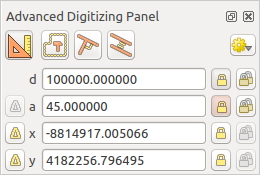
The Advanced Digitizing panel
Note
The tools are not enabled if the map view is in geographic coordinates.
The Advanced Digitizing panel can be open either with a right-click on the toolbar and choose Advanced Digitizing panel or in . Once the panel is visible, click the  enable advanced digitizing tool button to activate the Advanced Digitizing tool.
enable advanced digitizing tool button to activate the Advanced Digitizing tool.
Concepts¶
The aim of the Advanced Digitizing tool is to lock coordinates, lengths, and angles when moving the mouse during the digitalizing in the map canvas.
You can also create constraints with relative or absolute reference. Relative reference means that the next vertex constraints' values will be relative to the previous vertex or segment.
Snapping Settings¶
Click the  button to set the Advanced Digitizing Tool snapping settings. You can make the tool snap to common angles. The options are:
button to set the Advanced Digitizing Tool snapping settings. You can make the tool snap to common angles. The options are:
- Do not snap to common angles
- Snap to 30º angles
- Snap to 45º angles
- Snap to 90º angles
You can also control the snapping to features. The options are:
- Do not snap to vertices or segments
- Snap according to project configuration
- Snap to all layers
Keyboard shortcuts¶
To speed up the use of Advanced Digitizing Panel, there are a couple of keyboard shorcuts available:
| Key | Simple | Ctrl + or Alt + | Shift + |
|---|---|---|---|
| d | Set distance | Lock distance | |
| a | Set angle | Lock angle | Toggle relative angle to last segment |
| x | Set x coordinate | Lock x coordinate | Toggle relative x to last vertex |
| y | Set y coordinate | Lock y coordinate | Toggle relative y to last vertex |
| c | Toggle construction mode | ||
| p | Toggle perpendicular and parallel modes | ||
Absolute reference digitizing¶
When drawing a new geometry from scratch, it is very useful to have the possibility to start digitizing vertexes at given coordinates.
For example, to add a new feature to a polygonal layer, click the  button. You can choose the X and Y coordinates where you want to start editing the feature, then:
button. You can choose the X and Y coordinates where you want to start editing the feature, then:
Two blue dotted lines and a green cross identify the exact coordinates you entered. Start digitizing by clicking on the map canvas; the mouse position is locked at the green cross.
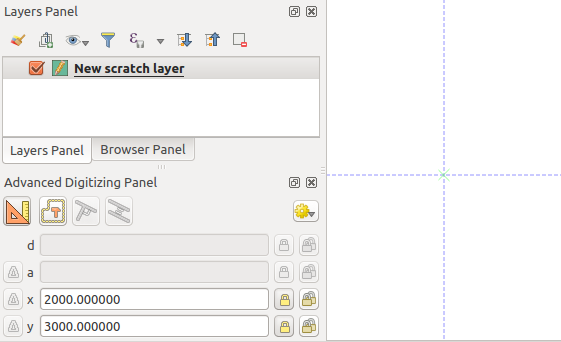
Start drawing at given coordinates
You can continue digitizing by free hand, adding a new pair of coordinates, or you can type the segment's length (distance) and angle.
If you want to draw a segment of a given length, click the d (distance) text box (keyboard shortcut d ), type the distance value (in map units) and press Enter or click the  button on the right to lock the mouse in the map canvas to the length of the segment. In the map canvas, the clicked point is surrounded by a circle whose radius is the value entered in the distance text box.
button on the right to lock the mouse in the map canvas to the length of the segment. In the map canvas, the clicked point is surrounded by a circle whose radius is the value entered in the distance text box.

Fixed length segment
Finally, you can also choose the angle of the segment. As described before , click the a (angle) text box (keyboard shortcut a ), type the angle value (in degrees), and press Enter or click the  buttons on the right to lock it. In this way the segment will follow the desired angle:
buttons on the right to lock it. In this way the segment will follow the desired angle:
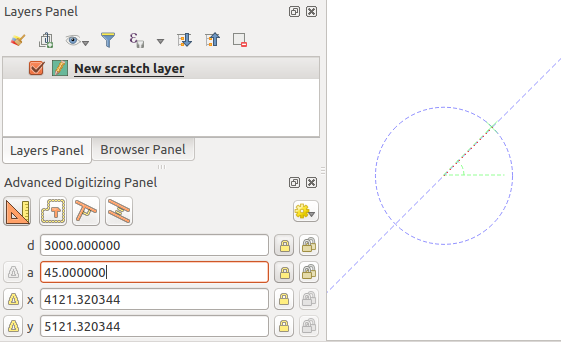
Fixed angle segment
Relative reference digitizing¶
Instead of using absolute values of angles or coordinates, you can also use values relative to the last digitized vertex or segment.
For angles, you can click the  button on the left of the a text box (or press Shift + a ) to toggle relative angles to the previous segment. With that option on, angles are measured between the last segment and the mouse pointer.
button on the left of the a text box (or press Shift + a ) to toggle relative angles to the previous segment. With that option on, angles are measured between the last segment and the mouse pointer.
For coordinates, click the  buttons to the left of the x or y text boxes (or press Shift + x or Shift + y ) to toggle relative coordinates to the previous vertex. With these options on, coordinates measurement will consider the last vertex to be the x and y axes origin.
buttons to the left of the x or y text boxes (or press Shift + x or Shift + y ) to toggle relative coordinates to the previous vertex. With these options on, coordinates measurement will consider the last vertex to be the x and y axes origin.
Continuous lock¶
Both in absolute or relative reference digitizing, angle, distance, x and y constraints can be locked continuously by clicking the  Continuous lock buttons. Using continuous lock allows you to digitize several points or vertexes using the same constraints.
Continuous lock buttons. Using continuous lock allows you to digitize several points or vertexes using the same constraints.
Parallel and perpendiculars line¶
All the tools described above can be combined with the  Perpendicular and
Perpendicular and  Parallel tools. These two tools allow drawing segments perfectly perpendicular or parallel to another segment.
Parallel tools. These two tools allow drawing segments perfectly perpendicular or parallel to another segment.
To draw a perpendicular segment, during the editing click the  Perpendicular icon (keyboard shortcut p ) to activate it. Before drawing the perpendicular line, click on the segment of an existing feature that you want to be perpendicular to (the line of the existing feature will be colored in light orange); you should see a blue dotted line where your feature will be snapped:
Perpendicular icon (keyboard shortcut p ) to activate it. Before drawing the perpendicular line, click on the segment of an existing feature that you want to be perpendicular to (the line of the existing feature will be colored in light orange); you should see a blue dotted line where your feature will be snapped:
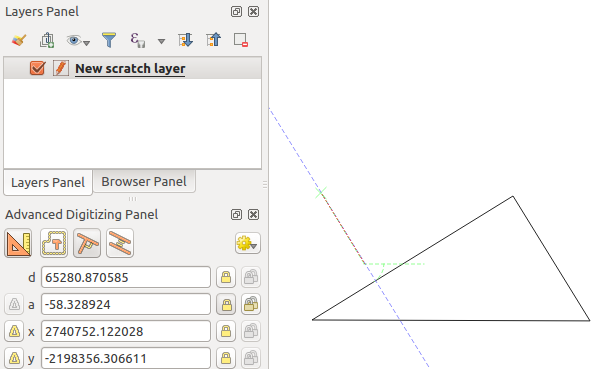
Perpendicular digitizing
To draw a parallel feature, the steps are the same: click on the  Parallel icon (keyboard shortcut p twice), click on the segment you want to use as reference and start drawing your feature:
Parallel icon (keyboard shortcut p twice), click on the segment you want to use as reference and start drawing your feature:
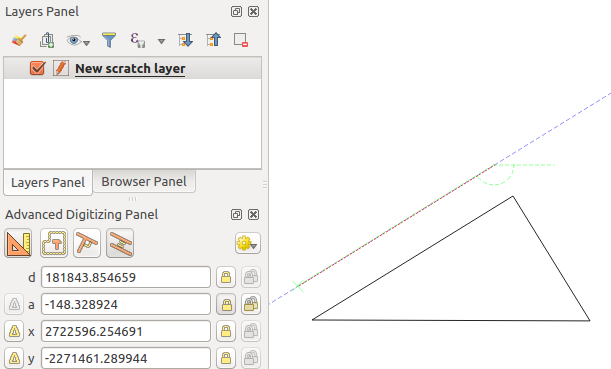
Parallel digitizing
These two tools just find the right angle of the perpendicular and parallel angle and lock this parameter during your editing.
Construction mode¶
You can enable and disable construction mode by clicking on the  Construction icon or with the c keyboard shortcut. While in construction mode, clicking the map canvas won't add new vertexes, but will capture the clicks' positions so that you can use them as reference points to then lock distance, angle or x and y relative values.
Construction icon or with the c keyboard shortcut. While in construction mode, clicking the map canvas won't add new vertexes, but will capture the clicks' positions so that you can use them as reference points to then lock distance, angle or x and y relative values.
As an example, the construction mode can be used to draw some point at an exact distance from an existing point.
With an existing point in the map canvas and the snapping mode correctly activated, you can easily draw other points at given distances and angles from it. In addition to the  button, you have to activate also the construction mode by clicking the
button, you have to activate also the construction mode by clicking the  Construction icon or with the c keyboard shortcut.
Construction icon or with the c keyboard shortcut.
Click next to the point from which you want to calculate the distance and click on the d box ( d shortcut) type the desired distance and press Enter to lock the mouse position in the map canvas:
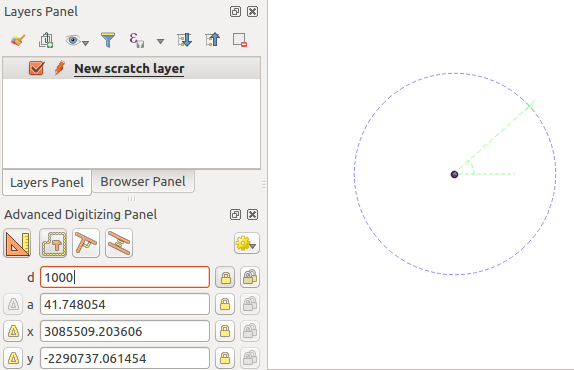
Distance from point
Before adding the new point, press c to exit the construction mode. Now, you can click on the map canvas, and the point will be placed at the distance entered.
You can also use the angle constraint to, for example, create another point at the same distance of the original one, but at a particular angle from the newly added point. Click the  Construction icon or with the c keyboard shortcut to enter construction mode. Click the recently added point, and then the other one to set a direction segment. Then, click on the d text box ( d shortcut) type the desired distance and press Enter . Click the a text box ( a shortcut) type the angle you want and press Enter . The mouse position will be locked both in distance and angle.
Construction icon or with the c keyboard shortcut to enter construction mode. Click the recently added point, and then the other one to set a direction segment. Then, click on the d text box ( d shortcut) type the desired distance and press Enter . Click the a text box ( a shortcut) type the angle you want and press Enter . The mouse position will be locked both in distance and angle.
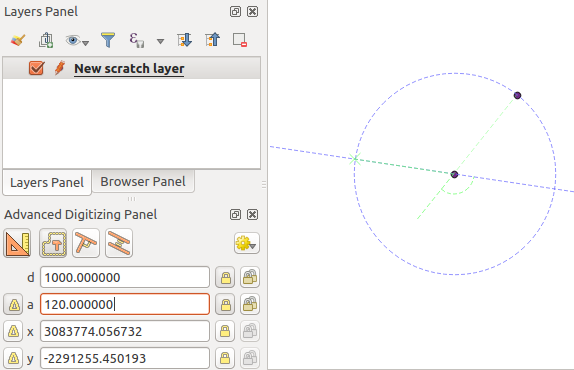
Distance and angle from points
Before adding the new point, press c to exit the construction mode. Now, you can click on the map canvas, and the point will be placed at the distance and angle entered. Repeating the process, several points can be added.
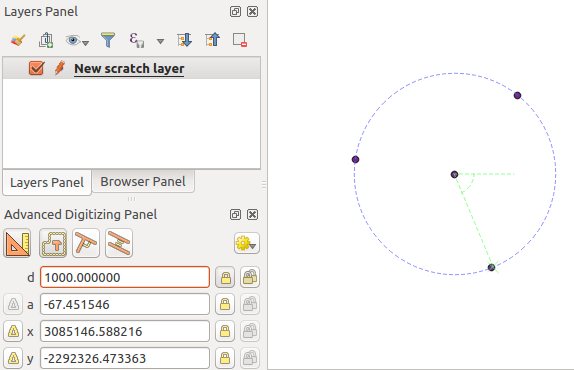
Points at given distance and angle
Source: https://docs.qgis.org/2.18/en/docs/user_manual/working_with_vector/editing_geometry_attributes.html
0 Response to "Arcmap No Polygons Were Created Ensure the Selected Form Continuous Rings and Overlap the Polygons"
Postar um comentário